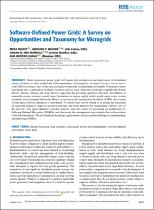 ResearchSpace
ResearchSpace
Software-defined power grids: A survey on opportunities and taxonomy for microgrids
JavaScript is disabled for your browser. Some features of this site may not work without it.
- ResearchSpace
- →
- Research Publications/Outputs
- →
- Journal Articles
- →
- View Item
| dc.contributor.author |
Ndiaye, M

|
|
| dc.contributor.author |
Hancke, GP

|
|
| dc.contributor.author |
Abu-Mahfouz, Adnan MI

|
|
| dc.contributor.author |
Zhang, H

|
|
| dc.date.accessioned | 2021-11-17T17:17:16Z | |
| dc.date.available | 2021-11-17T17:17:16Z | |
| dc.date.issued | 2021-07 | |
| dc.identifier.citation | Ndiaye, M., Hancke, G., Abu-Mahfouz, A.M. & Zhang, H. 2021. Software-defined power grids: A survey on opportunities and taxonomy for microgrids. <i>IEEE Access, 9.</i> http://hdl.handle.net/10204/12152 | en_ZA |
| dc.identifier.issn | 2169-3536 | |
| dc.identifier.uri | DOI: 10.1109/ACCESS.2021.3095317 | |
| dc.identifier.uri | http://hdl.handle.net/10204/12152 | |
| dc.description.abstract | Future generation power grids will require the introduction and deployment of distributed energy resources to meet modern-day load requirements. Consequently, we expect to see a rise in microgrids (MGs) existing as part of the main grid (grid-connected) or independent (islanded). Contained in these microgrids are a combination of energy resources such as solar, wind and fossil fuels coupled with storage devices, electric vehicles and smart devices supporting the prosumer operation. However, the addition of renewable energy resources would mean fluctuations in energy supply which would cause power system instability if not managed effectively. Hence, to maximize the management flexibility of MGs, the concept of microgrid software definition is introduced. A concept that can be looked at as giving the microgrid an operating system to improve operation response and event detection by maintaining a global view of the network. This paper therefore critically analyses what this entails by presenting an architecture for Software-Defined Microgrids (SDMGs) and discussing the management opportunities that softwarization of the MG introduces. We also highlight the design requirements and associated challenges in implementing and deploying SDMGs. | en_US |
| dc.format | Fulltext | en_US |
| dc.language.iso | en | en_US |
| dc.relation.uri | https://ieeexplore.ieee.org/abstract/document/9475973 | en_US |
| dc.source | IEEE Access, 9 | en_US |
| dc.subject | Energy balancing | en_US |
| dc.subject | Grid resiliency | en_US |
| dc.subject | Microgrids | en_US |
| dc.subject | Power grid management | en_US |
| dc.subject | Software-Defined Networking | en_US |
| dc.subject | Smart grids | en_US |
| dc.title | Software-defined power grids: A survey on opportunities and taxonomy for microgrids | en_US |
| dc.type | Article | en_US |
| dc.description.pages | 98973-98991 | en_US |
| dc.description.note | This work is licensed under a Creative Commons Attribution 4.0 License | en_US |
| dc.description.cluster | EDTRC Management | en_US |
| dc.description.impactarea | Next Generation Enterprises & Institutions | en_US |
| dc.identifier.apacitation | Ndiaye, M., Hancke, G., Abu-Mahfouz, A. M., & Zhang, H. (2021). Software-defined power grids: A survey on opportunities and taxonomy for microgrids. <i>IEEE Access, 9</i>, http://hdl.handle.net/10204/12152 | en_ZA |
| dc.identifier.chicagocitation | Ndiaye, M, GP Hancke, Adnan MI Abu-Mahfouz, and H Zhang "Software-defined power grids: A survey on opportunities and taxonomy for microgrids." <i>IEEE Access, 9</i> (2021) http://hdl.handle.net/10204/12152 | en_ZA |
| dc.identifier.vancouvercitation | Ndiaye M, Hancke G, Abu-Mahfouz AM, Zhang H. Software-defined power grids: A survey on opportunities and taxonomy for microgrids. IEEE Access, 9. 2021; http://hdl.handle.net/10204/12152. | en_ZA |
| dc.identifier.ris | TY - Article AU - Ndiaye, M AU - Hancke, GP AU - Abu-Mahfouz, Adnan MI AU - Zhang, H AB - Future generation power grids will require the introduction and deployment of distributed energy resources to meet modern-day load requirements. Consequently, we expect to see a rise in microgrids (MGs) existing as part of the main grid (grid-connected) or independent (islanded). Contained in these microgrids are a combination of energy resources such as solar, wind and fossil fuels coupled with storage devices, electric vehicles and smart devices supporting the prosumer operation. However, the addition of renewable energy resources would mean fluctuations in energy supply which would cause power system instability if not managed effectively. Hence, to maximize the management flexibility of MGs, the concept of microgrid software definition is introduced. A concept that can be looked at as giving the microgrid an operating system to improve operation response and event detection by maintaining a global view of the network. This paper therefore critically analyses what this entails by presenting an architecture for Software-Defined Microgrids (SDMGs) and discussing the management opportunities that softwarization of the MG introduces. We also highlight the design requirements and associated challenges in implementing and deploying SDMGs. DA - 2021-07 DB - ResearchSpace DP - CSIR J1 - IEEE Access, 9 KW - Energy balancing KW - Grid resiliency KW - Microgrids KW - Power grid management KW - Software-Defined Networking KW - Smart grids LK - https://researchspace.csir.co.za PY - 2021 SM - 2169-3536 T1 - Software-defined power grids: A survey on opportunities and taxonomy for microgrids TI - Software-defined power grids: A survey on opportunities and taxonomy for microgrids UR - http://hdl.handle.net/10204/12152 ER - | en_ZA |
| dc.identifier.worklist | 25029 | en_US |





